Towards the Design of P2P Energy Trading Scheme Based on Optimal Energy Scheduling for Prosumers
Abstract
1. Introduction
2. Overview of the P2P Energy Trading Scheme
2.1. Underlying Assumptions of P2P Energy Trading Scheme
- All P2P trading participants’ information about load forecasts, generation predictions, and the involvement of controllable generating facilities including energy storage system (ESS) in the P2P energy trading will be automatically transmitted to ETS through their intelligent electronic device (IED) prior to planning for the P2P energy trading.
- All energy prosumers attending the P2P energy trading must register data on technical properties of their own controllable generating and storage facilities at ETS in advance. This kind of information will be tagged as private and is not open to other market agents [13].
- There are no restrictions on eligibility criteria for energy prosumers who wish to attend the P2P energy trading. That is, massive players are free to participate in the P2P energy trading irrespective of their types and sizes. Moreover, no technological limitations on facilities for power supply are given.
- The commodity in the P2P energy trading is low-cost surplus electric power from energy prosumers, implying that the P2P energy trading is targeted to only end-users.
- The utility can play a passive role in the P2P energy trading to maintain the balance of supply and demand in energy for individual trading participants. Thus, the transaction price at the P2P energy trading must be set at levels that are slightly lower than the utility’s usage rates of electricity for the P2P power buyers.
- All energy prosumers can choose between selling their surplus to the utility and engaging in the P2P energy trading. To deter energy prosumers from selling back the electric power purchased from the utility, or to preclude arbitrage activities, the utility is supposed to purchase their surplus at a much cheaper contracted price than the utility’s usage rates of electricity applied to them. Consequently, energy prosumers cannot help but prefer trading their surplus on the basis of the P2P approach to reselling it to the utility. When it comes to the P2P energy trading scheme, it will prevail over the existing utility-based retail energy market.
- All trading participants need not undergo the separate bidding processes since the excessive transaction expenses, when considering their small electricity consumption, may be inevitably incurred from the repetitive bidding processes. For this reason, it may seem extraordinarily onerous to solicit their repeated bids for the strategic trading for the purpose of managing their own power usages.
- All trading participants are not obligated to stick to the optimal schedules for a trading period which will be drawn up by ETS. From the end-users’ point of view, they barely have strategic means enough to respond to the resulting recommendations and, at the same time, it is nearly impossible for them to conform to predetermined solutions due to inherent uncertainties. Simply put, ETS provides all trading participants with a useful point of reference on hourly transacted prices and amounts as well as the availability of opportunities for the P2P energy trading.
- The settlement standards for the P2P energy trading need to be arranged as well on account of the mere fact that an absence of the obligation to invariably uphold the optimal schedules of ETS should call for the additional settlement process after a trading period is terminated.
2.2. Mathematical Formulation of Optimal Energy Scheduling Problem for P2P Energy Trading
- Constraint on hourly quantity of electricity for the P2P energy trading: It means that the P2P energy trading will be facilitated only when the residual electric power by energy prosumers is always equal to or greater than the transacted volume by the P2P energy trading. In addition, it will enable energy prosumers to sell the remnants exceeding the trading amount to the utility at the predefined price:
- Constraint on hourly energy balancing of trading participants: It means that each load demand for trading participants must be fully satisfied by either their self-generation of electricity or power purchases from the utility and the P2P energy trading:
- Constraint on hourly participation in the P2P energy trading by energy prosumer: All energy prosumers can pursue the role of a seller or a buyer. However, when they decide to participate in the P2P energy trading at a certain moment, they must choose whether they serve as a seller or a buyer. In a mathematical formulation, an either-or approach like decision-making of joining the P2P energy trading can be tackled with the binary variable:
- Constraints on hourly maximum power received from the utility for the energy prosumer: All trading participants’ energy balancing can be ascribed solely to the purchase of electricity from the utility and the P2P trading. Since the purchase of electricity from the utility by the energy prosumer depends on the role of participation in the P2P energy trading, the constraint on hourly maximum power received from the utility can be imposed by taking advantage of the conditional binary variable:
- Constraint on operation of the distributed generation equipment: The hourly operational states and generation of distributed generation equipment owned by energy prosumers are strongly influenced by technical specifications of the corresponding generating units, which will be associated with constraints of the optimization problem.
- Constraint on maximum and minimum generation of the distributed generation equipment: The power output of online distributed generation equipment at a given time must be within the reasonable operational limits. Once the generating unit is switched off, its power output must be designated as zero. It can be ascertained by employing the binary variable of operational states for the distributed generation equipment:
- Constraint on ramping rates of the distributed generation equipment: The ramping rate is the physical characteristic to express how quickly a generating unit’s power output is changing, either increasing or decreasing. Hence, its power output will be affected in the consecutive trading intervals by these ramping-up and ramping-down restrictions [18]:
- Constraint on operation of the energy storage system (ESS): In fact, hourly charging and discharging states as well as the amount of energy stored in ESS are governed by technical requirements pertinent to the operation of ESS. In the following, several features will be introduced and tailored to the constraints of the optimal P2P energy scheduling model.
- Constraint on charging and discharging powers in ESS: The charging and discharging powers extracted from ESS for a trading period will certainly be bound by maximum permissible capacities for each operational mode and dominated by the installed capacity of power conditioning system (PCS) in ESS:
- Constraint on state-transition for the energy level in ESS: At a specific moment, the state of charge (SOC) in ESS heavily relies on the charging and discharging powers as well as the conversion efficiency based on the SOC in a previous step [19]. Shortly, the state-transition equation for the energy level in ESS can be constructed in a sequential manner:
- Constraint on SOC in ESS: The SOC in ESS must be observed in accordance with prescribed conditions to ensure the natural life cycles of ESS:
2.3. Determination of Transaction Price at P2P Energy Trading
2.4. Implementation of Settlement Standards for P2P Energy Trading
- The cleared sales of energy prosumers: The cleared sales of energy prosumers are the smaller of the actual surplus and the optimized one computed by the mathematical model:
- The cleared purchases of end-users: The amount of electric power which end-users can buy from the P2P energy trading will be restricted by the electric power which can be supplied by energy prosumers. Therefore, the cleared purchases of end-users will be calibrated by the ratio of total cleared sales to the sum of estimated ones by all energy prosumers when compared with the purchases of end-users predicted by the optimal energy scheduling model:
- The revenues from sales of electricity by energy prosumers:
- The payments for purchases of electricity by end-users:
3. Numerical Results
4. Discussion
5. Conclusions
Author Contributions
Funding
Acknowledgments
Conflicts of Interest
Abbreviations
| Forecasted load demand for trading participant at time | |
| Forecasted generation of renewables owned by trading participant at time | |
| Maximum capacity of lead-in wire for trading participant | |
| Usage rate of electricity by utility applied to trading participant at time | |
| Fuel cost of distributed generation equipment | |
| Start-up cost of distributed generation equipment | |
| Lower limit to power output of distributed generation equipment | |
| Upper limit to power output of distributed generation equipment | |
| Maximum flexible ramping-up output of distributed generation equipment | |
| Maximum flexible ramping-down output of distributed generation equipment | |
| Maximum charging capacity of energy storage system | |
| Maximum discharging capacity of energy storage system | |
| Minimum state of charge in energy storage system | |
| Maximum state of charge in energy storage system | |
| Charging efficiency of energy storage system | |
| Discharging efficiency of energy storage system | |
| Estimated purchases of electric power from utility for trading participant at time | |
| Estimated purchases of electric power by P2P trading for trading participant at time | |
| Estimated sales of electric power by P2P trading for trading participant at time | |
| Planned generation of distributed generation equipment owned by trading participant at time | |
| Planned discharging power of energy storage system owned by trading participant at time | |
| Planned charging power of energy storage system owned by trading participant at time | |
| State of charge in energy storage system owned by trading participant at time | |
| Operational state for distributed generation equipment owned by trading participant at time (0: offline, 1: online) | |
| Conditional role of participation in P2P trading by trading participant at time (0: seller, 1: buyer) | |
| Operational mode of energy storage system owned by trading participant at time (0: charging state or offline, 1: discharging state) | |
| Index of indicating the possibility of P2P trading at time (0: no clearing, 1: clearing) | |
| Transaction price of P2P trading at time | |
| Transmission tariff by utility | |
| Set of trading participants purchasing electricity by P2P trading at time | |
| Actual sales of electric power by P2P trading for trading participant at time | |
| Cleared sales of electric power by P2P trading for trading participant at time | |
| Cleared purchases of electric power by P2P trading for trading participant at time | |
| Revenues from sale of electric power by P2P trading for trading participant at time | |
| Payments for purchase of electric power by P2P trading for trading participant at time | |
| Weighted average trading price for the overall trading period |
References
- United Nations Framework Convention on Climate Change (UNFCCC). Available online: https://unfccc.int/ (accessed on 5 August 2020).
- Paris Agreement. Available online: https://unfccc.int/files/essential_background/convention/application/pdf/english_paris_agreement.pdf (accessed on 5 August 2020).
- Dick, C.I.; Praktiknjo, A. Blockchain technology and electricity wholesale markets: Expert insights on potentials and challenges for OTC trading in Europe. Energies 2019, 12, 832. [Google Scholar] [CrossRef]
- Yu, Y.; Guo, Y.; Min, W.; Zeng, F. Trusted transactions in micro-grid based on blockchain. Energies 2019, 12, 1952. [Google Scholar]
- Sousa, T.; Soares, T.; Pinson, P.; Moret, F.; Baroche, T.; Sorin, E. Peer-to-peer and community-based markets: A comprehensive review. Renew. Sustain. Energy Rev. 2019, 104, 367–378. [Google Scholar] [CrossRef]
- Fell, M.J.; Schneiders, A.; Shipworth, D. Consumer demand for blockchain-enabled peer-to-peer electricity trading in the United Kingdom: An online survey experiment. Energies 2019, 12, 391. [Google Scholar] [CrossRef]
- Strielkowski, W.; Streimikiene, D.; Fomina, A.; Semenova, E. Internet of energy (IoE) and high-renewables electricity system market design. Energies 2019, 12, 4790. [Google Scholar] [CrossRef]
- Zhang, C.; Wu, J.; Long, C.; Cheng, M. Review of existing peer-to-peer energy trading projects. Energy Procedia 2017, 105, 2563–2568. [Google Scholar] [CrossRef]
- Park, C.; Yong, T. Comparative review and discussion on P2P electricity trading. Energy Procedia 2017, 128, 3–9. [Google Scholar] [CrossRef]
- Jogunola, O.; Ikpehai, A.; Anoh, K.; Adebisi, B.; Hammoudeh, M.; Son, S.-Y.; Harris, G. State-of-the-art and prospects for peer-to-peer transaction-based energy system. Energies 2017, 10, 2106. [Google Scholar] [CrossRef]
- Baghaee, H.R.; Mirsalim, M.; Gharehpetian, G.B.; Talebi, H.A. Reliability/cost-based multi-objective Pareto optimal design of stand-alone wind/PV/FC generation microgrid system. Energy 2016, 115, 1022–1041. [Google Scholar] [CrossRef]
- Camillo, F.M.; Castro, R.; Almeida, M.E.; Pires, V.F. Economic assessment of residential PV systems with self-consumption and storage in Portugal. Sol. Energy 2017, 150, 353–362. [Google Scholar] [CrossRef]
- Morstyn, T.; Mcculloch, M. Multi-class energy management for peer-to-peer energy trading driven by prosumer preferences. IEEE Trans. Power Syst. 2019, 34, 4005–4014. [Google Scholar] [CrossRef]
- Carrión, M.; Arroyo, J.M. A computationally efficient mixed-integer linear formulation for the thermal unit commitment problem. IEEE Trans. Power Syst. 2006, 21, 1371–1378. [Google Scholar] [CrossRef]
- Huang, H.; Nie, S.; Lin, J.; Wang, Y.; Dong, J. Optimization of peer-to-peer power trading in a microgrid with distributed PV and battery energy storage systems. Sustainability 2020, 12, 923. [Google Scholar] [CrossRef]
- Guerrero, J.; Chapman, A.C.; Verbic, G. Decentralized P2P energy trading under network constraints in a low-voltage network. IEEE Trans. Smart Grid 2018, 10, 5163–5173. [Google Scholar] [CrossRef]
- Lazaroiu, G.C.; Dumbrava, V.; Roscia, M.; Zaninelli, D. Energy trading optimization of a virtual power plant on electricity market. In Proceedings of the 9th International Symposium on Advanced Topics in Electrical Engineering, Bucharest, Romania, 7–9 May 2015; pp. 911–916. [Google Scholar]
- Pan, K.; Guan, Y.; Watson, J.; Wang, J. Strengthened MILP formulation for certain gas turbine unit commitment problems. IEEE Trans. Power Syst. 2016, 31, 1440–1448. [Google Scholar] [CrossRef]
- Fu, M.; Xu, Z.; Wang, N.; Lyu, X.; Xu, W. “Peer-to-peer plus” electricity transaction within community of active energy agents regarding distribution network constraints. Energies 2020, 13, 2408. [Google Scholar] [CrossRef]
- Wang, N.; Xu, W.; Xu, Z.; Shao, W. Peer-to-peer energy trading among microgrids with multidimensional willingness. Energies 2018, 11, 3312. [Google Scholar] [CrossRef]
- Etukudor, C.; Couraud, B.; Robu, V.; Früh, W.G.; Flynn, D.; Okereke, C.; Gacanin, H. Automated negotiation for peer-to-peer electricity trading in local energy markets. Energies 2020, 13, 920. [Google Scholar] [CrossRef]
- Zhang, J.; Hu, C.; Zheng, C.; Rui, T.; Shen, W.; Wang, B. Distributed peer-to-peer electricity trading considering network loss in a distribution system. Energies 2019, 12, 4318. [Google Scholar] [CrossRef]
- Zhou, Y.; Wu, J.; Long, C. Evaluation of peer-to-peer energy sharing mechanisms based on a multiagent simulation framework. Appl. Energy 2018, 222, 993–1022. [Google Scholar] [CrossRef]
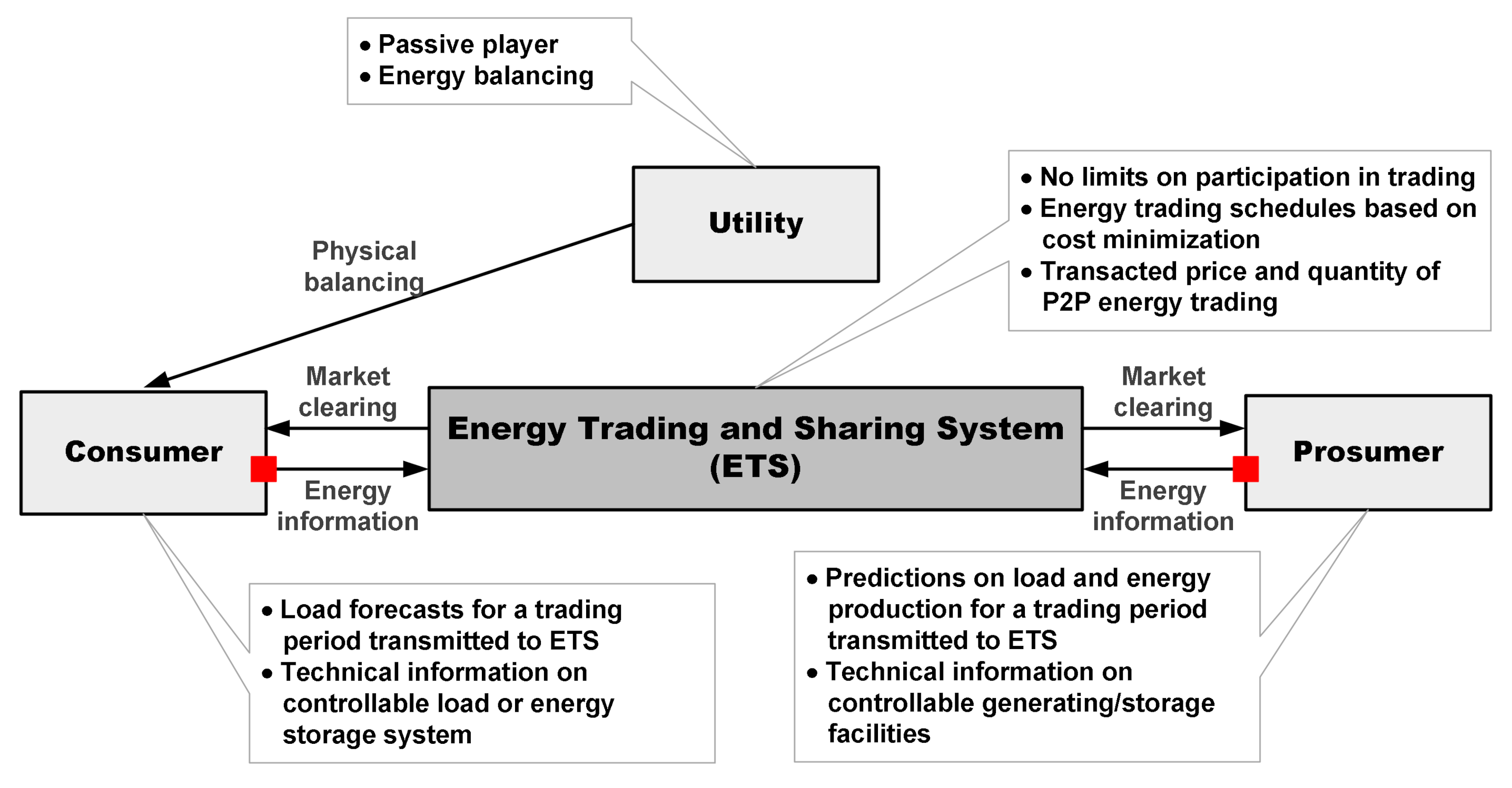
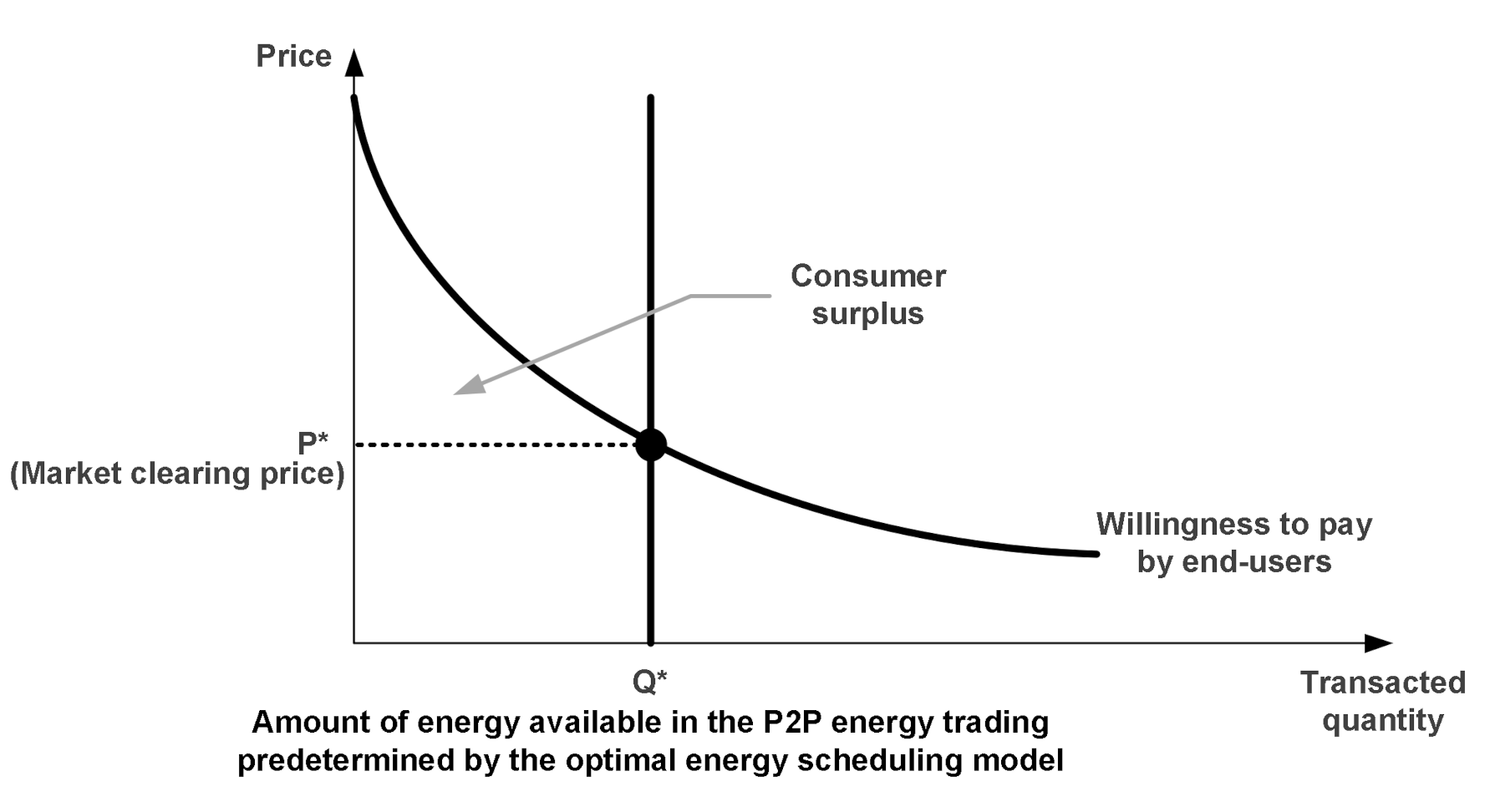

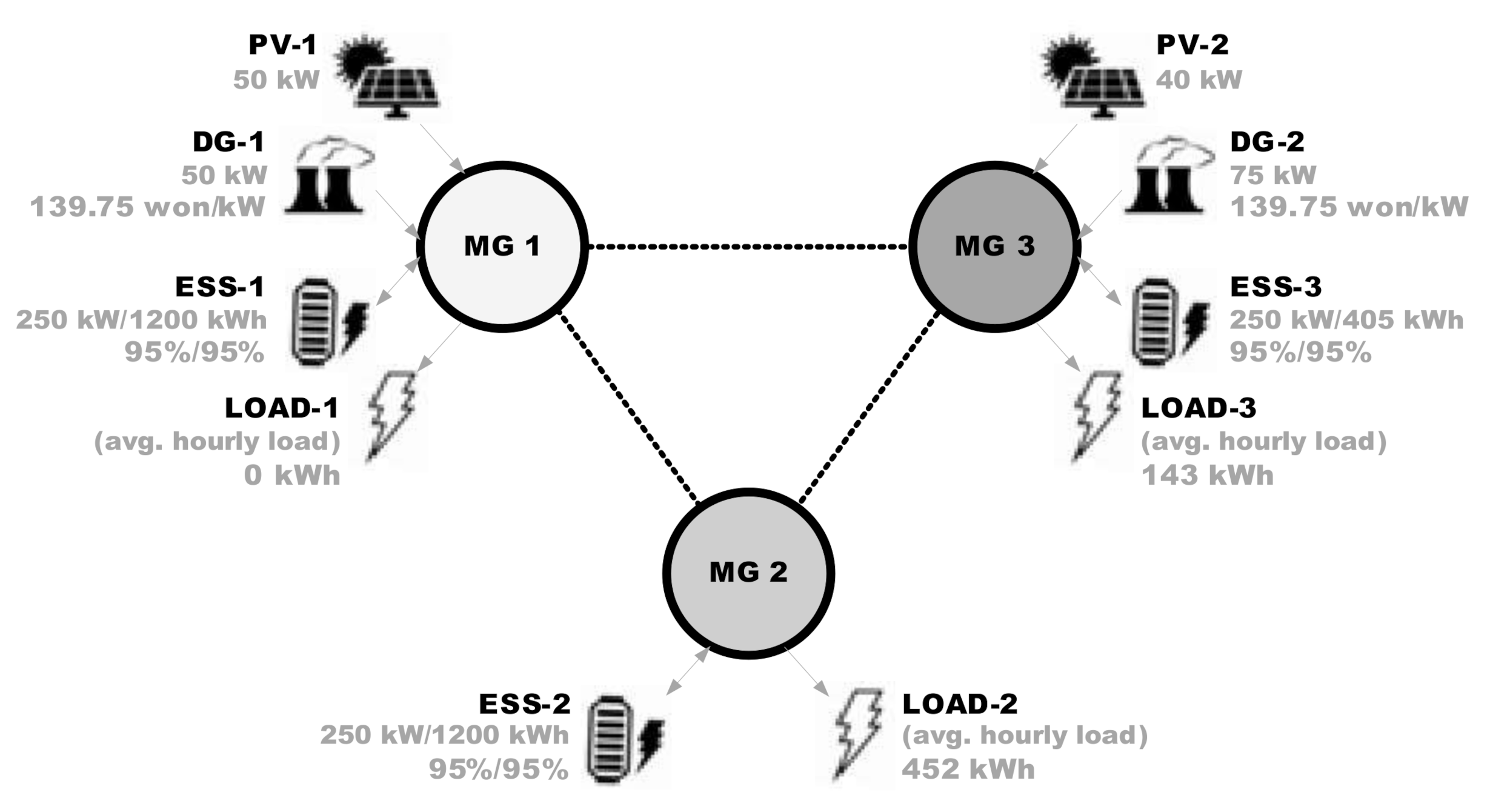
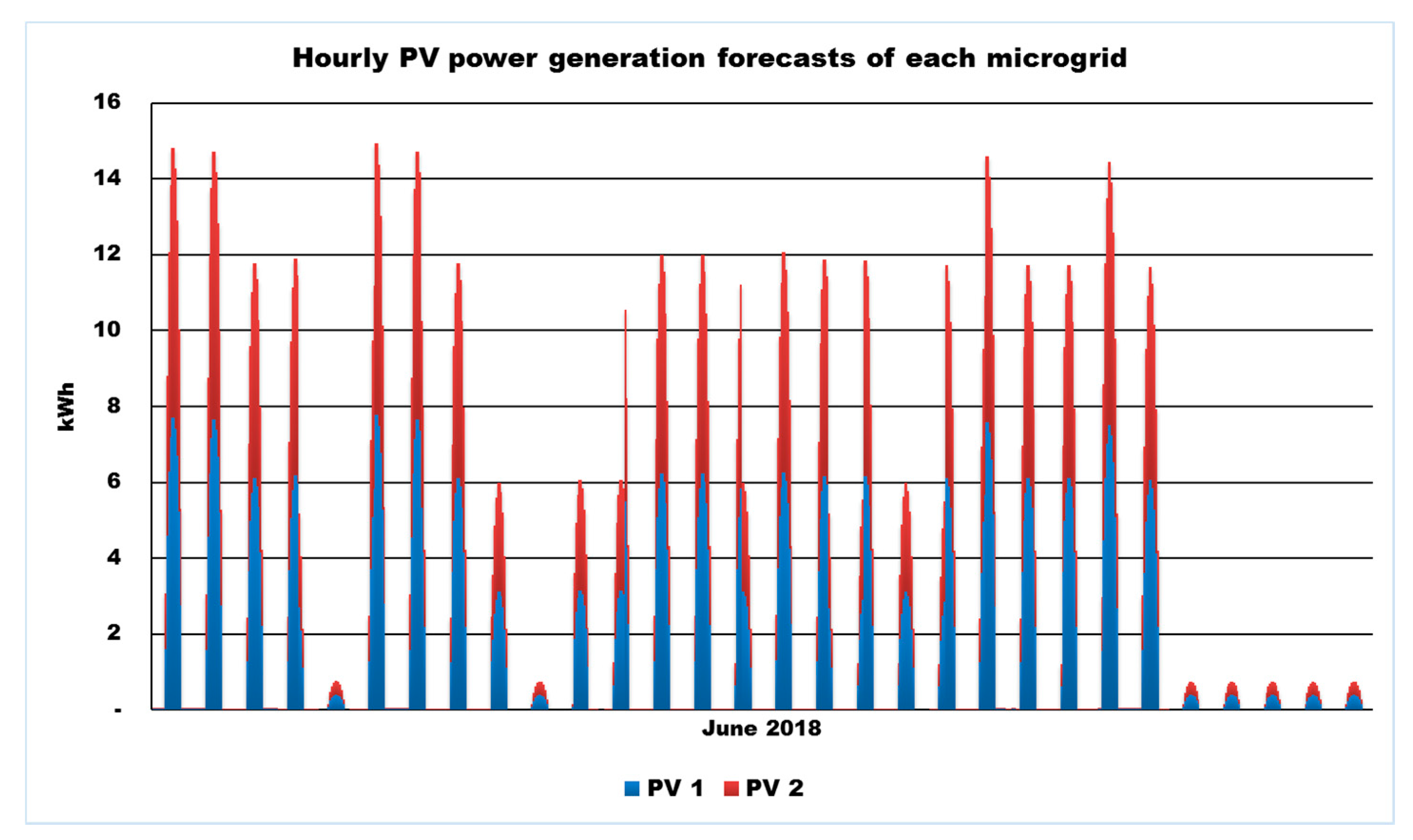

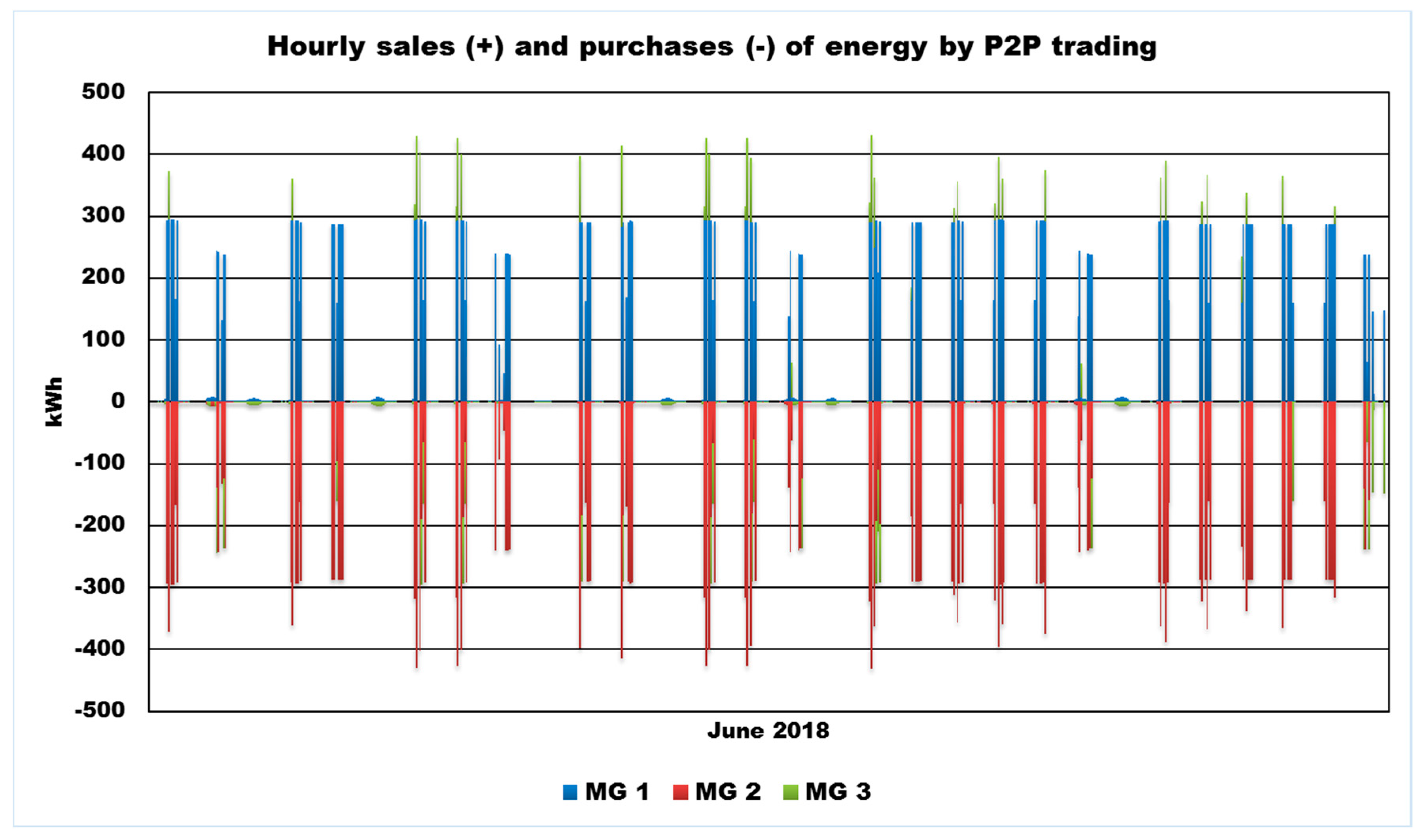
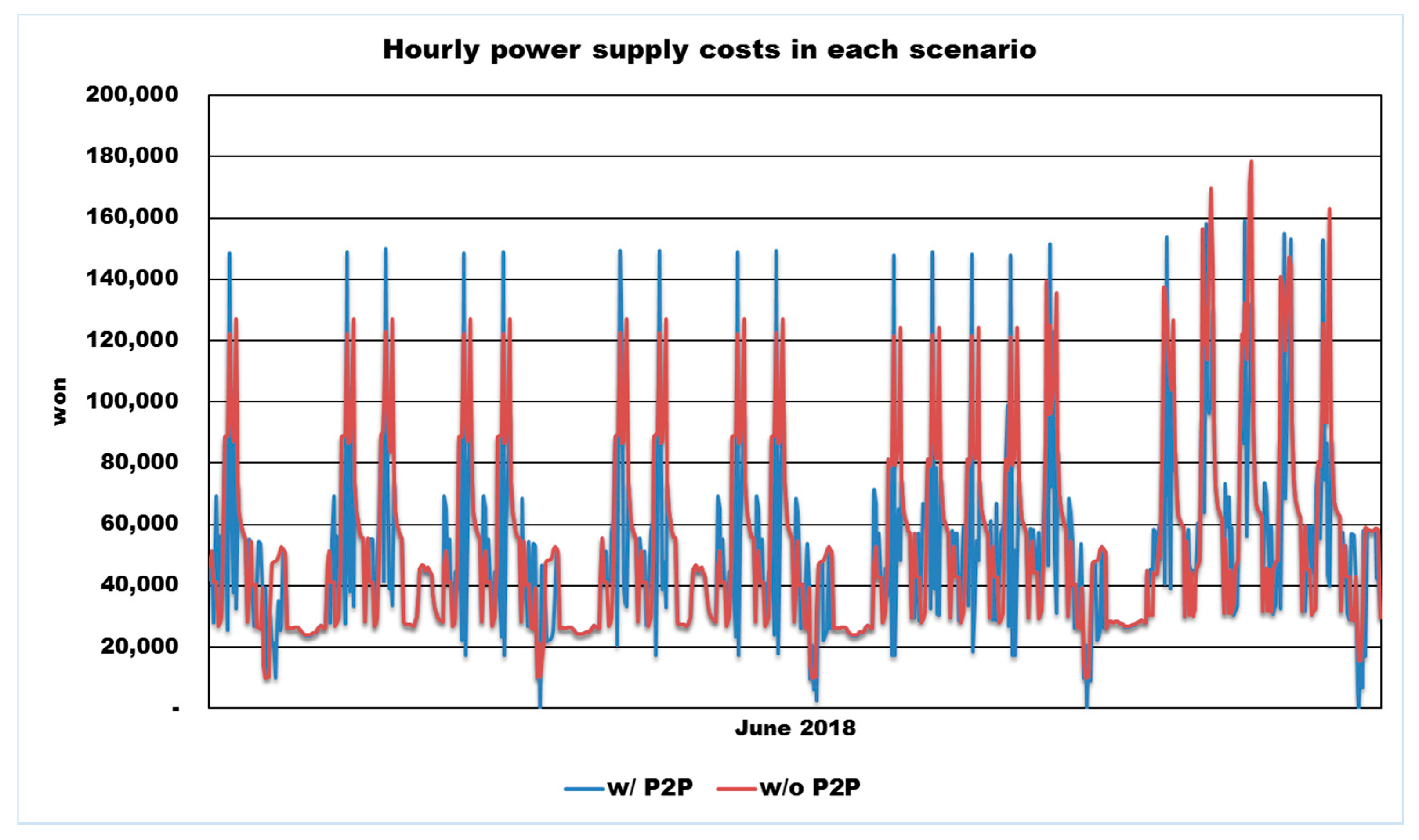
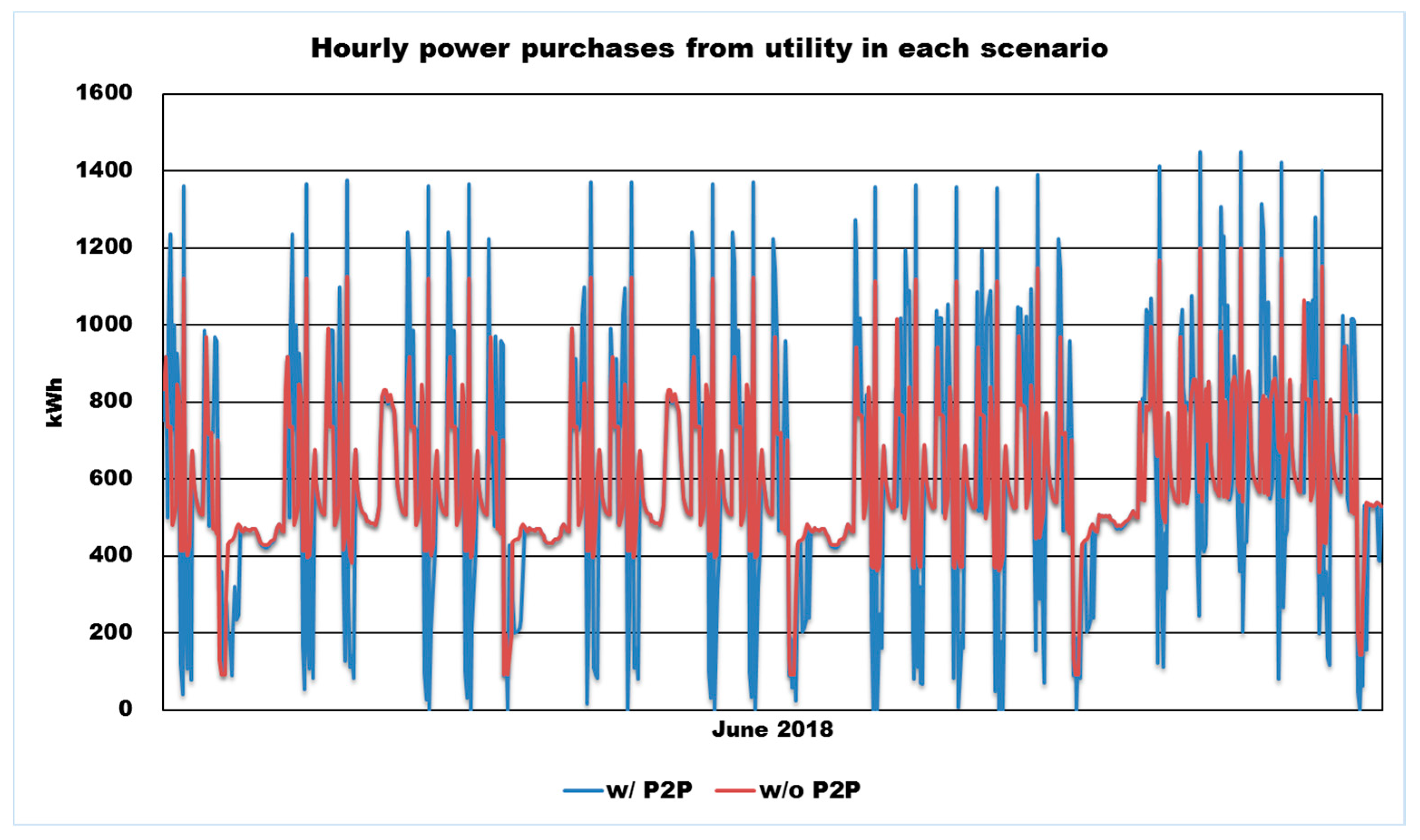
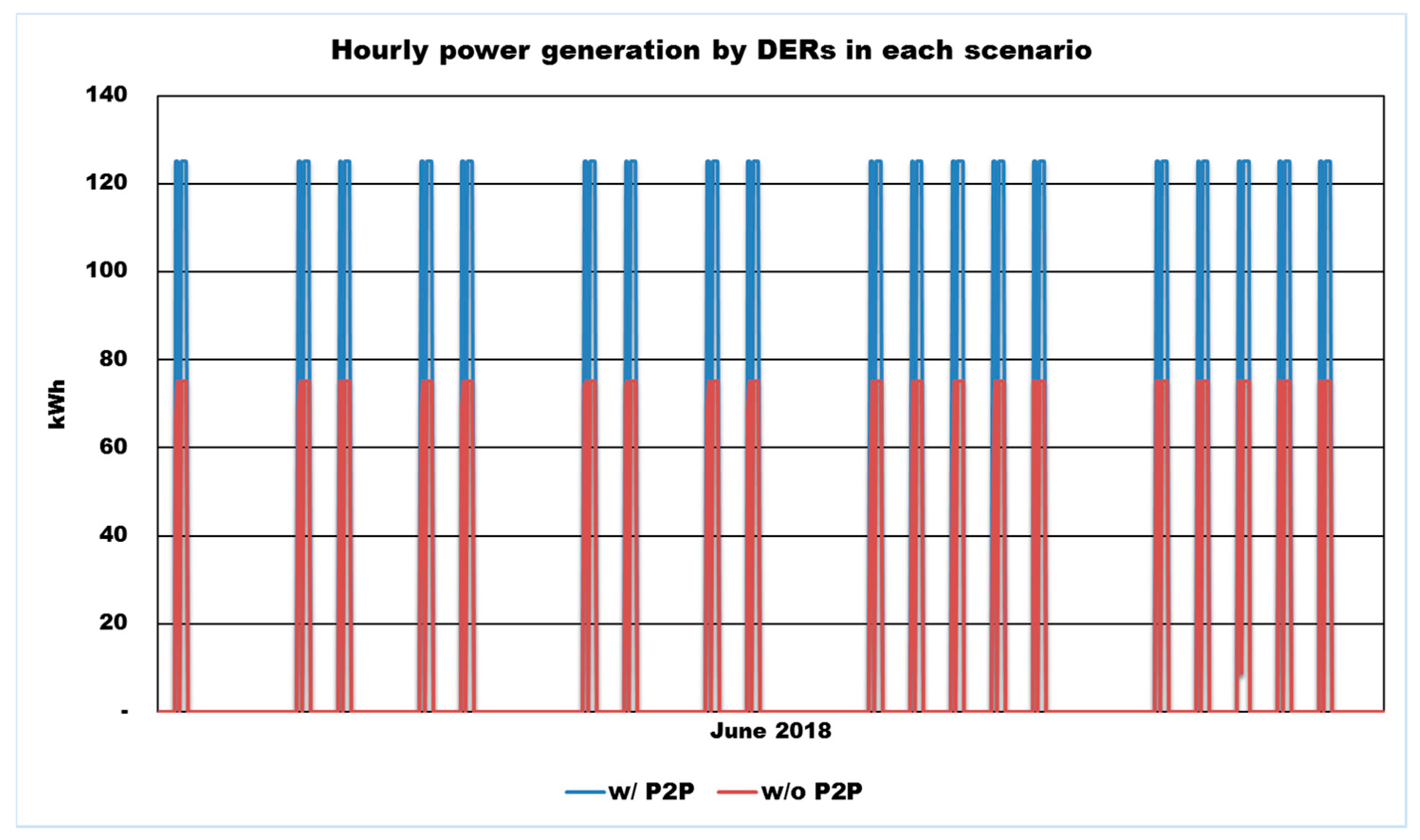

| Sales by P2P [kWh] | Purchases by P2P [kWh] | Revenues by P2P [won 1] | |
|---|---|---|---|
| MG 1 | 36,668 | 0 | 6,325,516 |
| MG 2 | 0 | 36,502 | −6,408,418 |
| MG 3 | 2733 | 2899 | 82,902 |
| Total volume of trading | 39,401 | 39,401 | N/A |
| Power Supply Costs[won] | MG 1 | MG 2 | MG 3 | Total |
|---|---|---|---|---|
| w/P2P | 3,003,450 | 24,207,085 | 8,752,604 | 35,963,139 |
| w/o P2P | 0 | 30,798,195 | 8,678,014 | 39,476,209 |
| Difference | 3,003,450 | −6,591,110 | 74,590 | −3,513,070 |
| Power Purchases from Utility [kWh] | MG 1 | MG 2 | MG 3 | Total |
| w/P2P | 34,966 | 293,640 | 95,200 | 423,086 |
| w/o P2P | 0 | 330,143 | 95,503 | 425,646 |
| Difference | 34,966 | −36,503 | −303 | −1840 |
| Generation by DERs [kWh] | DG 1 | DG 2 | Total | |
|---|---|---|---|---|
| w/P2P | 5700 | 8559 | 14,259 | |
| w/o P2P | 0 | 8421 | 8421 | |
| Difference | 5700 | 138 | 5838 | |
| Discharging Powers by ESS [kWh] | ESS 1 | ESS 2 | ESS 3 | Total |
| w/P2P | 30,065 | 26,951 | 12,845 | 69,861 |
| w/o P2P | 0 | 26,951 | 12,845 | 39,796 |
| Difference | 30,065 | 0 | 0 | 30,065 |
© 2020 by the authors. Licensee MDPI, Basel, Switzerland. This article is an open access article distributed under the terms and conditions of the Creative Commons Attribution (CC BY) license (http://creativecommons.org/licenses/by/4.0/).
Share and Cite
Chung, K.-H.; Hur, D. Towards the Design of P2P Energy Trading Scheme Based on Optimal Energy Scheduling for Prosumers. Energies 2020, 13, 5177. https://doi.org/10.3390/en13195177
Chung K-H, Hur D. Towards the Design of P2P Energy Trading Scheme Based on Optimal Energy Scheduling for Prosumers. Energies. 2020; 13(19):5177. https://doi.org/10.3390/en13195177
Chicago/Turabian StyleChung, Koo-Hyung, and Don Hur. 2020. "Towards the Design of P2P Energy Trading Scheme Based on Optimal Energy Scheduling for Prosumers" Energies 13, no. 19: 5177. https://doi.org/10.3390/en13195177
APA StyleChung, K.-H., & Hur, D. (2020). Towards the Design of P2P Energy Trading Scheme Based on Optimal Energy Scheduling for Prosumers. Energies, 13(19), 5177. https://doi.org/10.3390/en13195177






